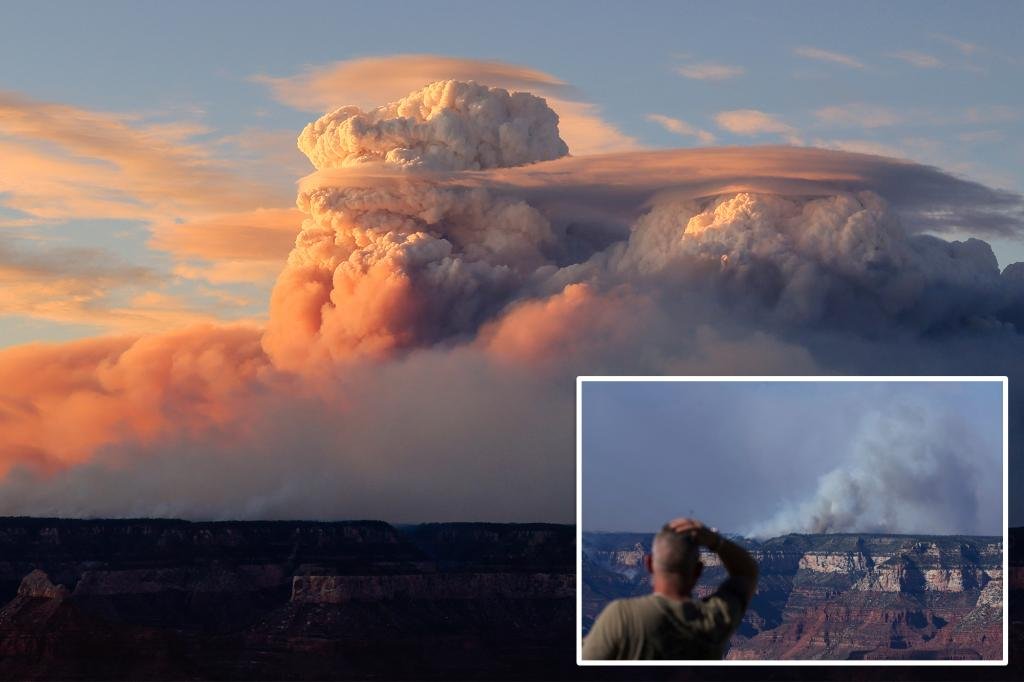Wildfires Rage in Western U.S., Prompting Evacuations and Safety Concerns
Two significant wildfires are currently active in the western United States, with one evolving into a “megafire” near the northern edge of the Grand Canyon, generating extremely high heat and leading to the formation of “fire clouds.” These clouds can create unstable local weather conditions.
In Arizona, wildfires driven by strong winds have already destroyed the Grand Canyon Lodge. The fire has consumed over 164 square miles (424 square kilometers) and is now classified among the top ten largest fires in Arizona’s history, with only 9% containment reported.
In a similar scenario, a major fire in Monroe, Utah, has burned 75 square miles (194 square kilometers) since July 13, with about 11% contained as of Thursday, according to officials.
Evacuations were ordered for several towns along the fire’s path on Wednesday, where damaged power poles have left nearby communities without electricity.
On Thursday, Utah’s Governor Spencer Cox declared a state of emergency as the fires continued to expand, and he plans to visit Monroe on Friday.
Challenges Posed by “Fire Clouds”
Fire Information Officer Lisa Jennings explained that a towering convection cloud, known as a Pyrocumulus cloud, has lingered over Arizona’s wildfires for seven days. The heat from the fire leads to rising air, which mixes with smoke to create these dangerous clouds.
These large swirling formations can be visible from miles away and resemble anvil shapes.
A more dangerous variant, the Pyrocumulonimbus cloud, has caused sudden gusts of wind as columns of smoke from the Utah fire have collapsed. Jennings noted that high columns can create downdrafts, which can swiftly spread flames and pose risks to ground firefighters.
Several firefighters in Utah had to retreat on Wednesday due to the unpredictable conditions created by these clouds, putting their safety at risk.
While firefighters in both states have managed some control over the flames, rapid growth has hindered their containment efforts.
Similar clouds, recognized by NASA, recently spawned a fire tornado in Eastern Utah, with wind speeds reaching an estimated 122 mph (196 km/h).
Derek Maria, an atmospheric scientist from the University of Utah, likened fire behavior to that of a hot air balloon, suggesting that rising heat and moisture contribute to evolving cloud formations. He indicated that climate change is likely increasing the frequency of these events due to extended fire seasons and harsher weather conditions.
The Grand Canyon “Megafire”
Though not an official term, a “megafire” typically refers to fires burning at least 156 square miles (404 square kilometers), which is about half the area of New York City. The Dragon Bravo Fire at the North Rim of Grand Canyon National Park exceeded this threshold in a recent update.
This fire was ignited by lightning on July 4 and is currently being managed to support the park’s ecosystem. About a week after its ignition, efforts shifted to contain it as it threatened nearby historic cabins and the Grand Canyon Lodge.
The fire has destroyed multiple structures, resulting in the closure of the North Rim for the remainder of the season as hundreds of firefighters battle to regain control.
Jennings noted that this past Thursday was particularly dry, marking eight consecutive days without significant humidity, with fuel moisture levels extremely low and wind gusts predicted to reach 35 mph (54.7 km/h).
With clouds reaching heights of at least 25,000 feet (7,620 meters), fire behavior analyst Arthur Gonzalez explained that they could climb even higher.
While consistent wind patterns have aided crews managing the Dragon Bravo Fire, the unpredictability of pyrocuumulus cloud development means that safety precautions must be implemented promptly.
Power Outages in Utah
On Thursday, the hot, dry winds contributed to the spread of the Monroe Canyon Fire, which has already burned down numerous electric poles, leaving many homes without power since Wednesday afternoon.
The National Weather Service has issued alerts regarding the dangers posed by extreme fire conditions in central and southwestern Utah.
In Antimony, located 54 miles (87 km) south of Monroe, residents have been without electricity, prompting Mayor Casey King to gather food and supplies for the community, which he fears might be insufficient for a week.
Efforts to restore power are underway by the Garkane Energy Cooperative, which has deployed a backup generator in response to the outages.
Antimony resident Marnie Reynolds expressed concern for the elderly in her community, as she uses a camp stove to prepare meals for neighbors and a generator to keep essential items refrigerated.
In Litchfield, Utah, about ten miles (16 km) north of Monroe, Lee Stevens reported that the ash from the fires has coated his garden. Although neither he nor his wife, both sensitive to smoke, have received evacuation notices yet, they remain prepared for any escalation of the fire.
According to the National Interagency Fire Center, many areas continue to be at risk for new outbreaks and rapid flame spread, despite fewer overall acres burned so far this year.







